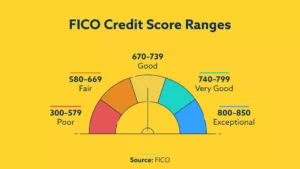FICO® has decided too many Americans have good credit scores.
The most widely used credit scoring model will soon be making an adjustment that may result in 40 million people experiencing a 20 point drop in credit scores according to FICO® reps.
Here is why.
Currently, the average credit score is at an all-time high of 703 according to a report from Experian. Credit scores at or above 700 is typically an indicator of good credit.
But according to FICO® and other experts, the current FICO® scoring model artificially inflates consumer’s credit scores.
To be fair, every few years FICO® makes adjustments in the credit scoring system based on the vast amount of data it tracks about consumer behavior and patterns.
In tweaking the scoring formula every few years, FICO® intends the newest formula to reflect current best practices for predicting consumer credit risk.
However, most lenders are still using the FICO® 8 version which came about in 2009 despite FICO® 9 being released in 2016.
What we can safely assume about the newest FICO® 10 version is that lenders will take their time upgrading. This is good news for consumers. You can start making adjustments now to protect your scores from the estimated 20 point loss 40 million consumers might experience.
What’s remains the same about FICO® 10
The FICO® Score 10 range will be the same as previous versions of FICO® Scores: 300 to 850. FICO® 10 continues to look at the same categories to calculate your credit score:
- 35% On-Time Payment History – Missed payments will kill your scores.
- 30% Amounts Owed – Also known as credit utilization. Using as much available credit you have lowers your score.
- 15% Credit Age – The longer you’ve had open good standing credit, the better your scores.
- 10% Recent Applications – Applying for several credit accounts over a short period of time makes you look risky to lenders.
- 10% Mix of Credit – Lenders want you to have many types of credit like credit cards, mortgage, auto or student loans to show you can handle multiple types of loans.
What’s different about FICO® 10
FICO®’s goal is to try to get better so lenders can make more sound lending decisions. Here is what’s different:
▶︎Late payments. Previous scoring models focused on more recent account balances.
- FICO® 10 will weigh the previous 24-month delinquencies more heavily than past FICO® scoring models. Consumers with late payments on their records will be put at an even more severe disadvantage than previous scoring models.
▶︎Amounts owed. Consumers with a history of high utilization (the amount of credit you use vs. what you have available) will be penalized. As it is now, the current scoring model only gives lenders an idea of utilization at the time a lender pulls your credit history. That means you could max out your credit card but pay it down by the statement date and your credit score will not reflect high usage. If you have a low balance at the time a lender pulls your credit then that’s what would reflect positively. In other words, FICO® scores reflect consumers’ balances during roughly the most recent month tracked.
- Under FICO® 10, the last 24 months of utilization will be calculated in your credit score. The lender will see 24 months of your spending habits. Lenders will know if you’ve been maxing out your account even if you pay it off by the next billing cycle.
▶︎Personal loans. Personal loans will have a bigger impact. Current scoring models generally reflect positively on credit reports as long as you make payments on a timely basis, in the full amount required under the loan terms. Loans show your ability to manage debt responsibly.
- Under FICO® 10, consumers that take out consumer loans will be flagged. Unsecured debt has risen in recent years with consumers taking out debt consolidation loans to get rid of credit card debt, only to run-up those paid-off credit cards again. If a consumer has taken out a personal loan but continues to rack of debt on credit card balances, FICO® 10 will ding your scores even if you consistently pay on time every month.
- According to the Wall Street Journal, “consumer loan losses remain low compared with during the last recession, but consumer debts are at record highs, with many Americans forced to rely on debt to help fund their everyday lives.”
▶︎FICO® 10 will create a bigger gap between consumers deemed to be good and bad credit risks.
- Consumers with already-high FICO® scores who continue to manage loans well will likely get a higher score than under previous FICO® versions.
- Consumers with credit that needs improvement and who continue to miss payments or accumulate other negative items will experience a bigger score decrease than under previous scoring models.
5 Steps To Get Credit Files Ready For FICO® 10
1. Never pay late. Always pay by the time credit cards and other accounts when they are due. If you can only make the minimum due on credit cards, make sure that all credit accounts are paid before the due date. Enroll in autopay, with loan or card payments automatically taken from your bank account.
2. Try not to carry a month-to-month balance. If you carry a balance, pay as much as you can financially handle to get credit cards paid in full. Stick to a budget instead of reaching for a credit card. Keeping track of how much you’re actually spending each month can keep you from overspending and relying on credit cars to get by.
3. Increase your available credit. Increase your credit limits to have more credit available even if you’re not using it. Lenders want to see a consistently small balance on all accounts. Unused credit helps your credit scores. Example: You have a $1000 credit line and you spend $1000 means you’re using 100 percent of your available credit limit.
However, if you have a $30,000 credit line and you spend $1000, then you’re only using 3.3 percent of your available credit limit. When you do spend a high amount, you have a cushion of available, unused credit.
4. Be careful with personal loans. Consumers might be penalized simply for having personal loans on their credit reports under the FICO® 10 scoring model. This is a huge difference in how FICO® Scores have traditionally treated personal loans. Consumers have long used personal loans to consolidate credit card debt, this is a smart move since interest rates on personal loans can be much lower than those on credit cards.
However, if you use those newly paid-off credit cards to make new purchases—building up new balances while you’re also paying off the consolidation loan, your credit scores will take a hit. If you take out a personal loan make sure any credit card balances are at zero balance or at least very low account balance.
5. Keep your old accounts open. Keep old credit card accounts open unless you have a compelling reason to close them. Older credit accounts contribute to your overall credit limit and credit age – both of which benefit your credit scores.
Final thoughts on FICO 10 Scoring
The good news is that most lenders are still using FICO® 8 which came out in 2009, to make credit decisions. That means even though FICO® 10 was released this summer, it will be unlikely that most lenders will immediately begin to use it.
It will take some time for lenders to adjust, change comes slowly when it comes to implementing new FICO scoring models.


















